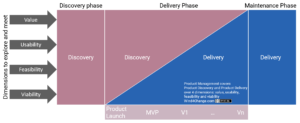Product Management & Discovery

Traditional Agile frameworks like Scrum and Kanban focus on Product Delivery. In this section, we concentrate on the overall process of Product Management and on the first part of this process, the Product Discovery coming before the Product Delivery.
Product Management, Product Discovery and Product Delivery, based on Inspired and Empowered by Marty Cagan
Product Management consists of Product Discovery and Product Delivery happening at the same time and interconnected. Product Management covers the 4 dimensions of a product: value, usability, feasibility and business viability.
Product Team vs Feature Team: what is the difference, as explained by Marty Cagan in Inspired and Empowered
What is a Product Team and what is the difference with a Feature Team? Surely, beyond the vocabulary, Marty Cagan explains in his books Inspired and Empowered the difference of concepts behind Product Team and Feature Team.
What is Product Design – Based on The Design of Everyday Things by Don Norman
Product Design consists in 3 domains of Design: Industrial Design, Interaction Design and Experience Design. The 7 fundamental principles of design as described by Don Norman consist in 2 areas grouping 7 principles. Understanding area covers Discoverability and Conceptual model. Discoverability area covers Affordances, Signifiers, Mappings, Constraints and Feedback.
Design Thinking by Stanford d school and Ideo
Design Thinking also called Human-Centered Design is a structured exploratory approach putting human being at the center to solve complex problems and/or create innovative products and services. Design Thinking starts with humans and their needs, fears and hopes to design a solution that is at the same time desirable, technically feasible, and economically viable.
Design Sprint from Google Venture by Jake Knapp
Design Sprint inspired from Design Thinking is a 5-step process conducted by an interdisciplinary team over a working week. Clearly, its purpose is to reduce risk of a new product or service by confirming the main assumptions or unknown with rapid prototyping and testing. Design Sprint consists in 5 steps after a preparation phase to set the stage: on Monday, Understand the problem, on Tuesday, Ideate on competing sketches of prototype, on Wednesday, Decide and plan for the Prototype, on Thursday, Build the Prototype, and finally, on Friday, Test the Prototype with customers.

